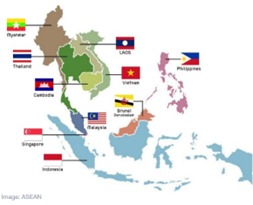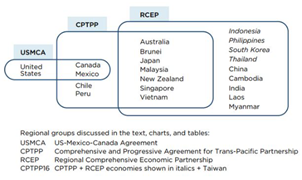TAG: GS-2: INTERNATIONAL RELATIONS
CONTEXT: NITI Aayog’s CEO recently said that India should join the Regional Comprehensive Economic Partnership (RCEP) and the Comprehensive and Progressive Agreement for Trans-Pacific Partnership (CPTPP).
EXPLANATION:
About Regional Comprehensive Economic Partnership (RCEP):
- The RCEP was signed in November 2020 and came into effect on January 1, 2022.
- India decided not to join RCEP because the agreement would harm its farmers, businesses, workers and consumers. It is a free trade agreement of the world’s largest trade bloc.
- It is the world’s largest free trade agreement by members’ GDP, with the 15 member countries accounting for about 30% of the world’s population and 30% of global GDP.
- It groups 15 Asia-Pacific economies, including Australia, Brunei Darussalam, Canada, Chile, China, Hong Kong, China, Indonesia, Japan, Republic of Korea, Malaysia, Mexico, New Zealand, Papua New Guinea, Peru, and Philippines
- The 10 member-states of the Association of Southeast Asian Nations (ASEAN).

- Members of ASEAN were Brunei, Cambodia, Indonesia, Lao PDR, Malaysia, Myanmar, Philippines, Singapore, Thailand, and Vietnam.
- Objectives:
- Trade -Reduce or eliminate tariffs and non-tariff barriers to trade.
- Economic growth – Promote economic growth and regional stability.
- Investment – Increase investment and encourage foreign investment.
- Supply chains – Facilitate trade and investment among member nations and enhance regional supply chains.
Significance of India joining RCEP and CPTPP:
- Enhanced Trade Opportunities: Joining RCEP and CPTPP could significantly boost India’s trade by providing access to larger markets, particularly in Asia-Pacific regions.
- These agreements encompass a wide range of goods and services, potentially increasing India’s exports, especially from its Micro, Small & Medium Enterprises (MSMEs), which account for 40% of exports.

- Integration into Global Supply Chains: Participation in these trade blocs would facilitate India’s integration into global supply chains, allowing it to benefit from the ‘China plus one’ strategy that many countries are adopting to diversify their supply sources away from China.
- This could enhance India’s manufacturing sector and attract foreign investment.
India’s current tariff structure in global trade?
| Average Tariffs | High Bound Tariffs |
|
|
Way forward:
- Selective Tariff Reductions and Safeguards for Sensitive Sectors: India should negotiate phased tariff reductions and secure safeguards for vulnerable sectors like agriculture and small manufacturing.
- This approach would protect local industries while allowing gradual integration into RCEP and CPTPP markets.
- Strengthening Domestic Industries and MSMEs: India can boost competitiveness by enhancing MSME support through targeted subsidies, infrastructure improvements, and technology upgrades. Strengthening these sectors will help India leverage new market access and build resilience against foreign competition.
Source:
Spread the Word
